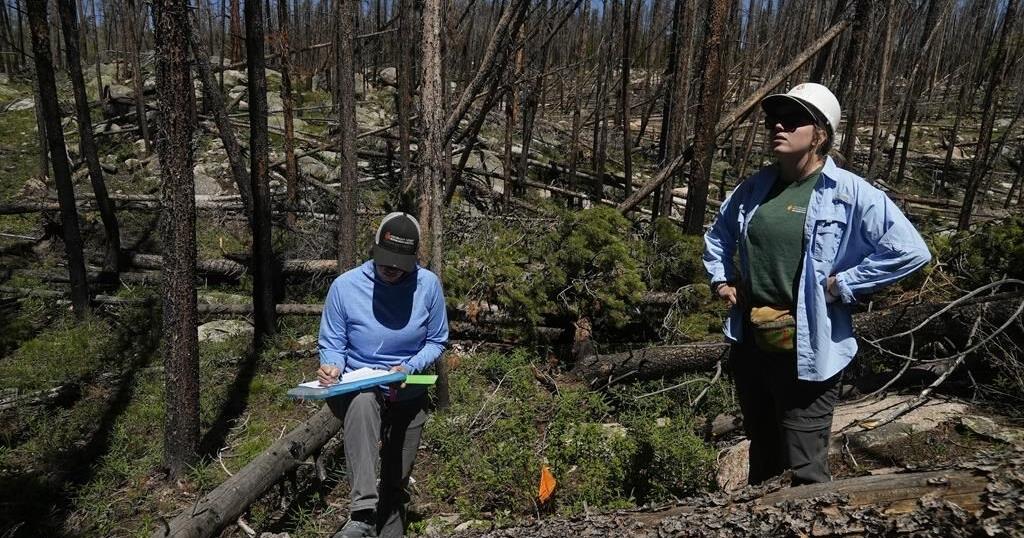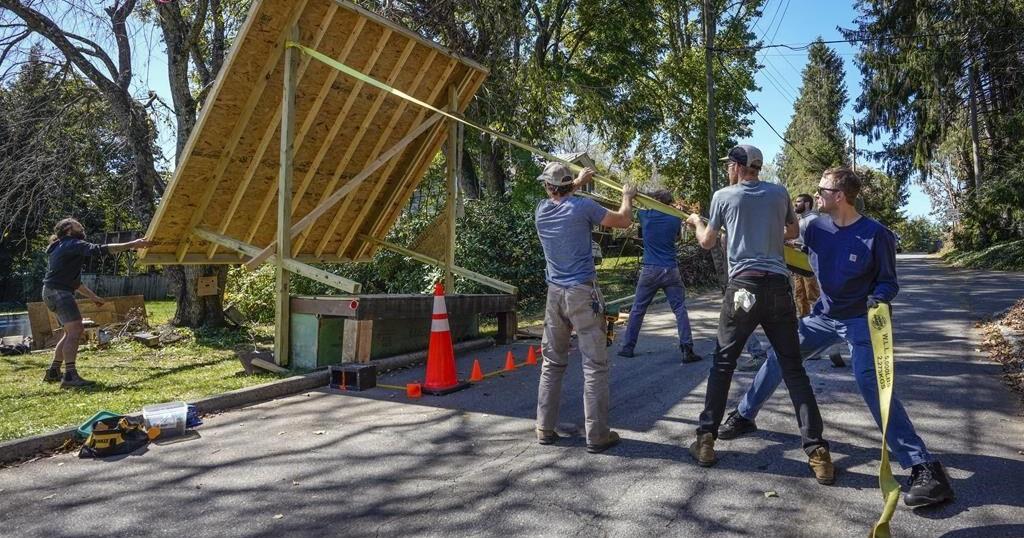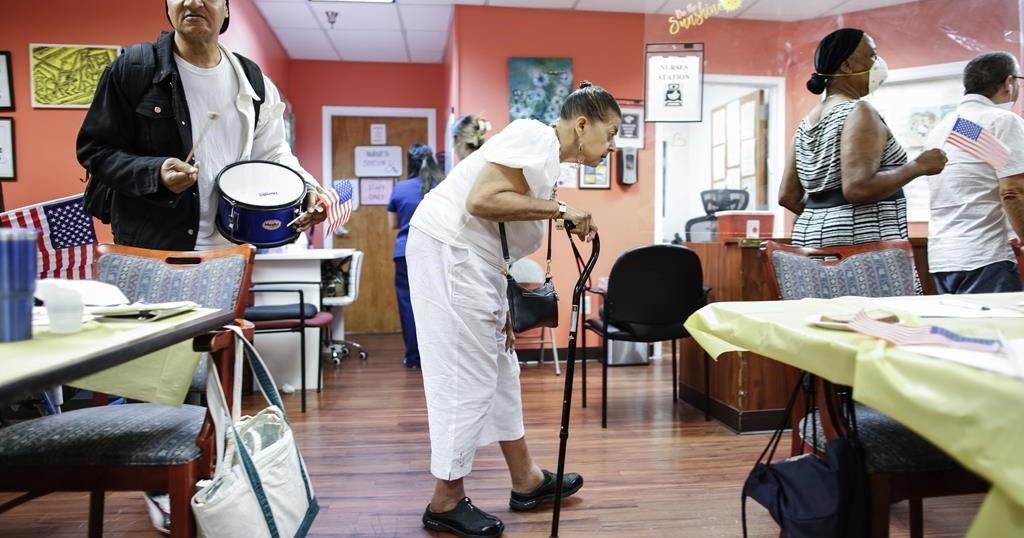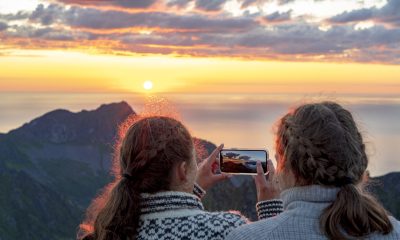BELLVUE, Colo. (AP) — Camille Stevens-Rumann crouched in the dirt and leaned over evergreen seedlings, measuring how much each had grown in seven months.
“That’s two to three inches of growth on the spruce,” said Stevens-Rumann, interim director at the Colorado Forest Restoration Institute.
Her research team is monitoring several species planted two years ago on a slope burned during the devastating 2020 Cameron Peak fire, which charred 326 square miles (844 square kilometers) in the Rocky Mountains of Colorado.
They want to determine which species are likely to survive at various elevations, because climate change makes it difficult or impossible for many forests to regrow even decades after wildfires.
As the gap between burned areas and replanting widens year after year, scientists see big challenges beyond where to put seedlings.
The U.S. currently lacks the ability to collect enough seeds from living trees and the nursery capacity to grow seedlings for replanting on a scale anywhere close to stemming accelerating losses, researchers say. It also doesn’t have enough trained workers to plant and monitor trees.
The Forest Service said the biggest roadblock to replanting on public land is completing environmental and cultural assessments and preparing severely burned areas so they’re safe to plant. That can take years — while more forests are lost to fire.
“If we have the seedlings but we don’t have the sites prepped … we can’t put the seedlings out there,” said Stephanie Miller, assistant director of a reforestation program.
Scientists, private industry and environmental agencies are acutely aware of the challenges as they consider how to restore forested landscapes in an increasingly arid region.
“We need to start being creative if we want trees on our landscapes,” Stevens-Rumann said. “We’re in a place of such drastic climate change that we are not talking about whether or not some of these places will be a different kind of forest, but whether or not they will be forests at all.”
Reforestation gap
Four years after the Cameron Peak fire — the largest in recorded Colorado history — a smattering of wild raspberry bushes and seedlings has taken root. But the mountainside mostly is dotted with charred trees.
In burn scars across the West and Southwest, areas of forests may never grow back on their own.
Larger and more intense fires destroy trees that normally provide seeds for regeneration or leave burn scars so large trees can’t naturally bridge the gap. The climate also has changed so markedly that many forests can’t regrow in the same places. Even when seedlings take hold, drought and new fires often kill them.
Nineteen of the 20 largest wildfires ever recorded in the contiguous U.S. have occurred in Western states since 2000, according to Sean Parks, a Forest Service research ecologist. That’s when the region slipped into an ongoing megadrought.
The U.S. once was able to reliably replant burned forests. But now the gap between areas in the West that need replanting after fire and the ability to do so has grown to at least 3.8 million acres (1.5 million hectares) — and that could triple by 2050, said Solomon Z. Dobrowski, a University of Montana forest management expert and a study lead author.
Forests are burning more often and especially intense and hot, which can destroy seeds that normally survive fire, harden the ground like concrete and leave barren slopes susceptible to washing away in rainstorms, polluting waterways.
In 22 years since the Hayman fire on Colorado’s front range burned 182 square miles (471 square kilometers) of forest, there has been almost no tree regeneration in the most severely burned areas, researchers and the Forest Service said.
In California’s Sierra Nevada, where up to 20% of the world’s mature giant sequoias and their seeds have been killed by fire in recent years, there are massive openings without seedlings. A U.S. Geological Survey study concluded some groves will never recover without replanting.
But researchers say the odds of forests growing back will worsen regardless of fire intensity because of more heat and drought.
That means burned forest could convert to shrubland and grassland, leading to loss of snowpack that provides drinking water and helps irrigate crops.
“Over 70% of our water in the western U.S. comes from our forested ecosystems and our mountains,” Stevens-Rumann said. “And for that water to come the way we want it … at the right time throughout the year, we need to have forests, not just grasslands.”
Targeted tree planting
When forest ecologist Matthew Hurteau joined the University of New Mexico nine years ago, he took in the aftermath of the 2011 Las Conchas fire that decimated a huge swath of Ponderosa pine forest.
Though the area had been replanted several times, most seedlings died, Hurteau said. While the average survival in the Southwest is about 25%, he said only about 13% of trees planted most recently in the Los Conchas burn scar have survived.
So he planted seedlings of different species at various elevations and on slopes facing different directions, then monitored the soil moisture, temperature and humidity.
A resulting computer model can predict the probability a seedling will survive in a particular spot with about 63% accuracy. It will be used to inform planting this fall.
“Let’s not do the old plant-and-pray” method, said Hurteau. “Let’s plant where we know that their chance of survival is quite high, and in places where the chance … is quite low, let’s just forego planting there.”
Researchers say seedling survival is worst at lower elevations, where it’s hotter, drier and more open — so replanting the same trees in the same areas is likely to fail.
They’re experimenting with planting near surviving trees that might provide shade for seedlings and aid water uptake and with planting in clusters that leave gaps in the landscape. Some are even asking whether different species should replace trees wiped out by fire.
Environmental groups working on private land burned by the Cameron Peak fire are replanting Ponderosa pines 500 feet (152 meters) higher because of climate change and near fallen trees that can provide shade, said Megan Maiolo-Heath, spokeswoman for the Coalition for the Poudre River Watershed.
So far, 84% of trees planted last year remain alive, though long-term survival is uncertain. “Any work in the environmental world at this point can feel daunting and overwhelming,” Maiolo-Heath said. “So I think just taking small bites … and trying not to get too overwhelmed is the way to go about it.”
Forest Service rules generally require planting the same species at the same elevations as before a fire, but it’s increasingly clear the agency will “need to be flexible moving forward,” said Jason Sieg, acting supervisor of the Arapaho and Roosevelt National Forests & Pawnee National Grassland.
Relying on research data, Sieg said, “We’ll be able to plan a strategy around how we set this landscape up for the greatest chance of success … long term.”
For now, that might mean replanting at different elevations or collecting seeds from another location. Eventually, researchers say it could require the controversial option of planting trees not found in an area originally.
Additional research and caution are necessary, researchers and the Forest Service said. But more people are warming up to the idea.
“I’ve seen people go from saying, ‘Absolutely, we cannot move trees around’ to, ‘Well, let’s maybe let’s try it at least, and do a few experiments to see if this will work,’” said Stevens-Rumann, the Colorado scientist.
Restoration challenges
Four years ago, researchers and New Mexico’s state forester wrote a reforestation plan for the state, where 4,500 square miles (11,655 square kilometers) of forest were charred between 2011 and 2021, leaving up to 2.6 million acres (1.5 million hectares) in need of replanting.
That was before the 2022 Calf Canyon-Hermits Peak Fire — the most destructive in state history — burned another 534 square miles (1,383 square kilometers).
They soon discovered a big problem.
“We realized that we were never going to have enough seedlings to meet the objectives,” said Hurteau, the University of New Mexico researcher.
The number of Forest Service nurseries — once financed by deposits on timber sales — dropped from 14 to six in the 1990s as timber harvests declined and habitat protections were enacted, according to a Forest Service report on the nurseries’ history.
Most Western seedling production is private and occurs in Oregon, California and Washington, Dobrowski said.
In places like New Mexico and the Rocky Mountains, “we don’t really have a base of facilities to support widespread reforestation,” the researcher said. “We’re (asking) ‘What’s going to fill the gap?’”
In New Mexico, several universities and the state’s forestry division started the New Mexico Reforestation Center with a goal of building a nursery that can produce 5 million seedlings per year for government, tribal and private lands. The first seedlings will be planted this year.
But experts say much more nursery capacity, seed collection and trained workers are needed to make even modest progress in closing the reforestation gap. And they say public and private sector cooperation will be essential.
“There’s all these bottlenecks,” Hurteau said. “We’ve just underinvested in reforestation for decades in the U.S. There’s a lot of investment in human capital that’s going to have to happen.”
Seed collection, for example, requires the right weather and is expensive and labor-intensive. It takes a few years for a typical Western conifer to develop cones. Then contractors must harvest them, typically by climbing trees. Growing, planting and monitoring seedlings amid more frequent droughts adds to the uncertainty, time and money.
The Forest Service said its biggest challenge is simply that the number of intense wildfires is outpacing the ability to prepare sites for replanting.
But the agency is also modernizing nurseries and seeking ways to either expand internal capacity or work with private industry, states and groups like the New Mexico Reforestation Center.
“This is an all-hands-on effort,” said Miller, from the reforestation program.
Researchers say the challenges complicate a Biden administration goal to plant a billion trees over 10 years in national forests, where it identified a nearly 4 million-acre (1.6 million-hectare) backlog.
But money provided for reforestation in the 2021 infrastructure bill enabled the agency to clear 15% of the backlog, Miller said. “If we can get more site preparation done, that would be excellent so that we can move forward a little bit faster.”
Experts say there clearly will be areas where trees never return but it’s critical that the U.S. does as much possible in a thoughtful way.
“Trees live for hundreds of years so we need to be thinking about what’s right as we plant trees today,” Hurteau said. “Are we putting the right species and densities on the landscape given what the next 100, 200 and 300 years will look like?”
___
AP data reporter Mary Katherine Wildeman contributed to this story from Hartford, Connecticut. Webber reported from Fenton, Michigan, and Fassett from San Francisco.
___
The Associated Press’ climate and environmental coverage receives financial support from multiple private foundations. AP is solely responsible for all content. Find AP’s standards for working with philanthropies, a list of supporters and funded coverage areas at AP.org.























